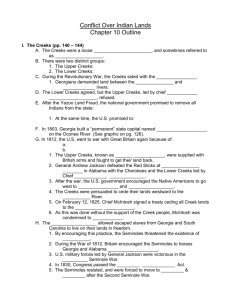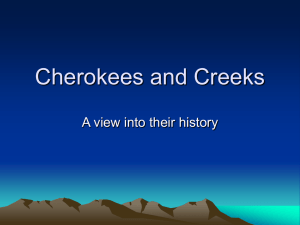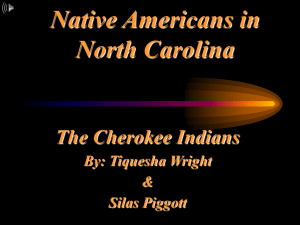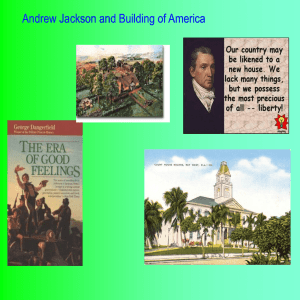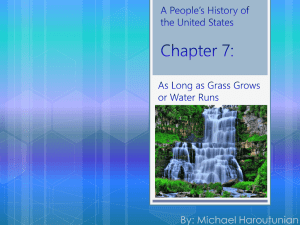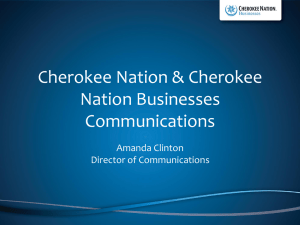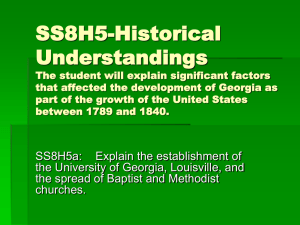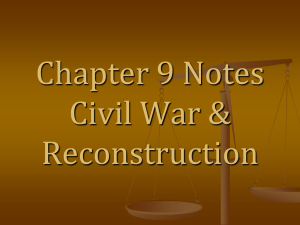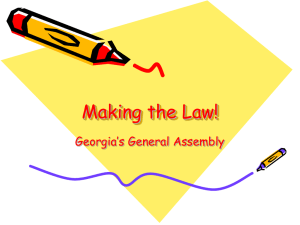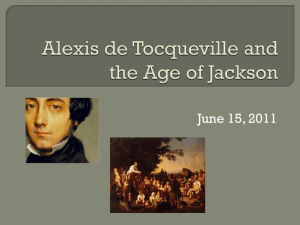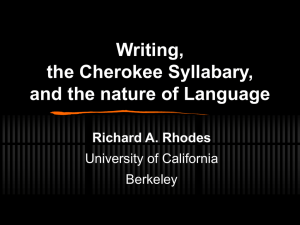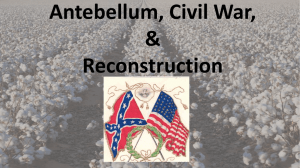Ch. 10 Conflict over Indian Lands.ppt
advertisement
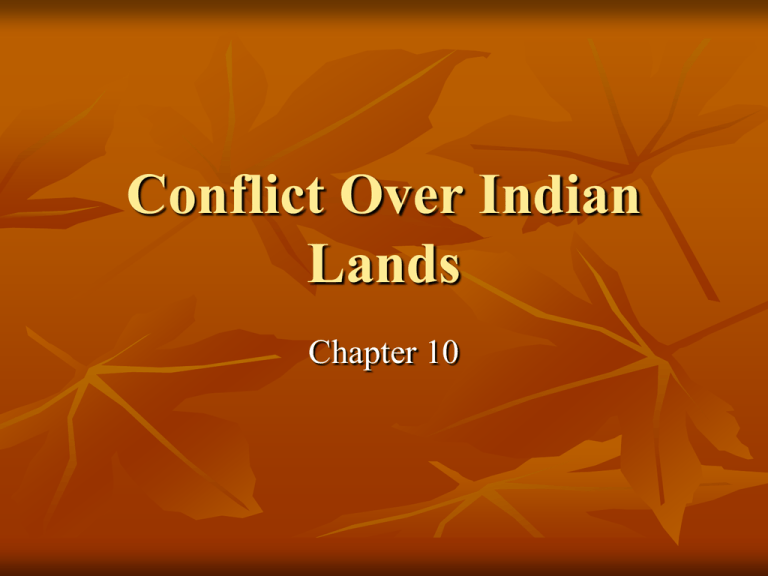
Conflict Over Indian Lands Chapter 10 Conflicting Views Only 105 years after white settlers came to Georgia, the Native American population was gone due to the one treasure the white setters wanted – land. Indians believed land could only be used, but never owned. Whites believed land was to be bought, sold or inherited. Tribal Leaders Alexander McGillivray, William McIntosh, John Ross, Elias Boudinot, and George Guess were defenders of Native Americans (mothers were N.A.) Native Americans took heritage of mother, so sons were accepted as well-educated members of both societies. Tribal chiefs had English and Native names to be able to “live in both worlds”. Georgia’s Native American Tribes Five major groups: Creeks, Cherokees, Seminoles, Choctaws (largest) and Chickasaws. Creeks not a single tribe (confederation), also known as Muscogees. Upper Creeks lived in towns in northern Alabama. Lower Creeks, some known as Seminoles, ended up in Florida. The chiefdom was run by chief (mico) and tribal council. Mico in charge of dealing with other chiefdoms or treaties with Whites. Conflict Between Creeks and Whites Georgians angry Creeks sided with British, so demanded their land between Ogeechee and Oconee rivers. Chief Alexander McGillivay of Upper Creeks refused. Met with G. Washington and gave up lands. Federal gov’t promised Georgia to remove Native Americans as soon as reasonably and peacefully possible. Creeks and Settlers Creeks and settlers fighting for land. Creeks eventually gave up land for money and goods. Col. Benjamin Hawkins became U.S. Indian Agent for Creeks. He tried to teach them modern farming skills and to keep peace (despite pressure from Whites for more land). War of 1812 In 1812 America went to war again with Britain (shipping and land rights). Lower Creeks sided with Americans, Upper Creek (Red Sticks) saw it as a chance to get land back. Creeks killed 500 people at Fort Sims in 1813. Gen. Andrew Jackson fought Red Sticks (with Cherokees and Creek Chief Willam McIntosh) for revenge. 700 Red Sticks killed that day. In Gen Jackson had all Creeks meet him at Ft. Jackson for “peace”. Although most had fought with him, Jackson forced them to give all land in South GA and Eastern Alabama. Pressure on Creeks After war Indians asked to go west (free land) or could no longer be separate nations. Creeks began adapting to white culture, but still owned lots of land in Georgia. Federal gov’t tried to “bargain” with Creeks. Most resisted giving up more land. Chief McIntosh Father was Scottish, mom was Creek. He was a first cousin to Governor Michael Troup. Fought under General Jackson against other Creeks at Horseshoe Bend. McIntosh given lots of money to get Creeks to sell remaining land. Then tried to give Cherokees money to sell their land. Cherokees warned Creeks to watch their chief. Chief McIntosh February 12, 1825 McIntosh signed treaty ceding all Creek lands to U.S. May 1, 1825 Creeks surrounded McIntosh’s house, set it on fire, and killed him. Gov. Troup wanted U.S. to enforce treaty, but Pres. John Adams said it wasn’t legal. Gov. Troup threatened war with U.S., so Adams backed down. Creeks had to sell. The Seminoles Accepted escaped slaves to live on their land and become members of tribe (Black Seminoles) White settlers angry over loss of slaves and War of 1812. Andrew Jackson won first Seminole War. In 1819 Spain ceded Florida to U.S.; Seminoles forced to Central Florida to live on reservation. 1830 Indian Removal Act Required consent and payment to Indians, but they were really forced to move. Land set aside in Oklahoma and Arkansas. 2nd Seminole War lasted 7 years. Entire Seminole tribe was forced to move to new Indian Territory out west. The Cherokees Lived in Appalachian Mts (TN, GA, NC and AL) able to avoid removal a little longer than Creeks. Often fought settlers (sided with British), defeated at Rome. Sided with US in Creek War of 1813 and 1814. Started out as towns and chiefdoms, but Cherokees wanted to unite more as a nation and unified government. The Cherokee Nation Best adapted to White culture Sequoyah (George Guess) taught other Cherokee language (syllabary) New Echota Cherokee captial – had similar constitution to U.S. Cherokee Phoenix bilingual newspaper Farmers and storeowners who often accepted Christianity. Cherokee Nation Recognized as government by U.S. but not Georgia Gold discovered in Cherokee territory – Lumpkin Co. becomes Georgia property (Dahlonega becomes county seat) 1828 General Assembly passed act to declare Cherokee laws “null and void” Indians could not testify against whites or sue a white person. The Downfall of the Cherokee Nation Cherokees go to Washington to protest (memorial), but Andrew Jackson became President. Jackson treats Indians as children and tells them to go west. GA upset that federal troops were sent to remove gold rushers from Cherokee land Protestant missionaries warned to take an oath of allegiance to Georgia. Downfall of the Cherokee Missionaries refused to say oath and jailed U.S. Supreme Court heard Worcester vs Georgia and agreed that Georgia laws didn’t apply to Cherokee nation. William Lumpkin, governor, disagreed, as did President Jackson. Refused to listen to the U.S. Supreme Court. The Cherokees would lose their land. Division of Cherokee Land Great land lottery of 1832 would include Cherokee land. 10 new counties created; Cherokee families forced out of their homes. Cherokees tried to be citizens of U.S., but Jackson refused. Some followed Chief John Ross in resisting moving west. The Ridge Faction One group, lead by Major Ridge, John Ridge and Elias Boudinot, sighed a treaty to give up land and move west for $5 mil. Many Cherokees angry this was done. Most Cherokees who stayed would be driven out of Georgia by white settlers. The Trail of Tears 1838: Genreal Winfield Scott rounded up last 15,000 Cherokees in Georgia to force them out. Some escaped to mountains and stayed there. Indians forced to walk in winter, killing thousands of men, women and children. 22 wealthy mixed families given citizenship, but had to buy back land won in lottery.
